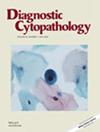A Retrospective Cytomorphologic Analysis of Salivary Gland Fine Needle Aspirates Classified as Salivary Gland Neoplasm of Uncertain Malignant Potential: A 6-year Institutional Experience
Abstract
Background
The Milan System for Reporting Salivary Gland Cytopathology is an effective reporting system for salivary gland fine needle aspirations with well-established risks of malignancy. Salivary gland neoplasm of uncertain malignant potential (SUMP) comprises a heterogenous group of lesions which have features that can be recognized as at least neoplastic but preclude further classification into benign or malignant. In this study, we reviewed the cytomorphologic features of salivary gland fine needle aspirations diagnosed as SUMP at our institution (over the past 6 years) and correlated those with the final diagnosis on surgical follow up.
Design
A retrospective search was performed to identify cases classified as SUMP at our institution from January 2018 to February 2024. Cytology slides were reviewed, and cases were subclassified based on key cytomorphologic features into the following categories: (1) basaloid, (2) oncocytic, (3) with clear cell features and (4) mixed features (myoepithelial/oncocytoid/squamoid features). Histologic diagnosis was recorded if available.
Results
A total of 36 cases of SUMP were identified; 31/36 had surgical follow up; final diagnosis included 22 benign lesions (2 non-neoplastic and 20 benign neoplasms), and nine malignant lesions. The overall risk of neoplasm and risk of malignancy were 93.5% and 29% respectively, with the oncocytic sub-category recording the highest ROM (42.8%). Mucoepidermoid carcinoma was the most common malignant diagnosis and pleomorphic adenoma the most common benign diagnoses.
Conclusions
Our study supports the subclassification of SUMP lesions based on key cytomorphologic features, thereby aiding in refining this ambiguous entity and providing a precise risk assessment.

 求助内容:
求助内容: 应助结果提醒方式:
应助结果提醒方式:


